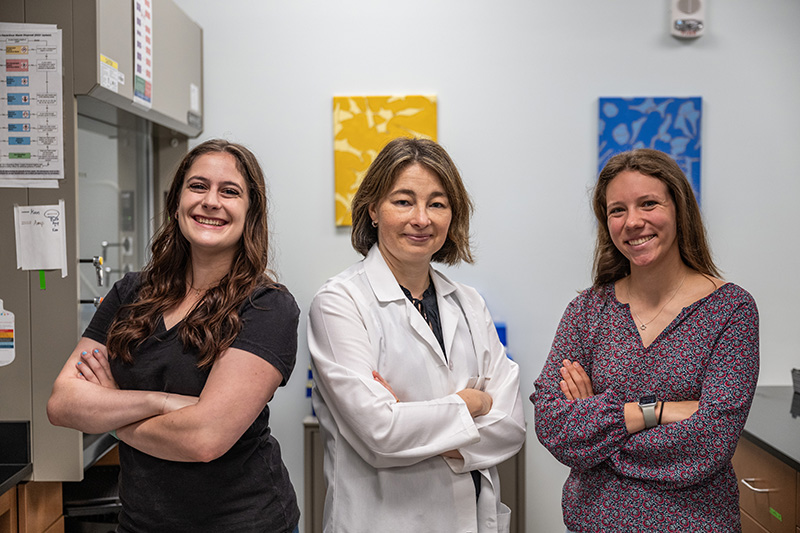
Associate Professor of Biological Sciences Anastasia Thévenin (center) stands with two of nine students—Hailey Belvario ’25 (l) and Sophia Shienvold ’24 (r)—who contributed to a research project that spanned more than four years. All of the students and Thévenin are named co-authors on the work, which was published in the Journal of Biological Chemistry.
They were told that undergraduate students couldn’t carry out the proposed research into gap junction intercellular communication. Nine Moravian University students led by Associate Professor of Biological Sciences Anastasia Thévenin proved them wrong, and their work was recently published in The Journal of Biological Chemistry.
Through a complex set of proteins and enzymes, cells talk to each other. What they say in these conversations can facilitate or disrupt cellular activities, be they healthy or unhealthy.
With the help of a team of nine undergraduate students, Anastasia Thévenin, associate professor of biological sciences at Moravian University, studied one facet of how cells communicate: examining the cancer-suppressing protein called connexin 43 (Cx43) and three major cell signaling proteins called MAP kinases (MAPKs). Thévenin and her team looked at the MAPK family of enzymes (ERK, JNK, and p38) and their unique ways of phosphorylating Cx43.
The research study, “Differential substrate specificity of ERK, JNK, and p38 MAP kinases toward connexin 43,” was recently published in The Journal of Biological Chemistry (JBC).
Thévenin’s JBC study was funded in part by an Academic Research Enhancement Award (AREA) R15 grant from the National Institutes of Health. She and her students studied a finite molecular process, but the implications they uncovered are huge. By controlling cellular conversations, scientists may someday be able to fine tune signals to promote healing and stop unhealthy processes, such as cancer, that begin at the molecular level.
To break down complex research in simple terms, Cx43 helps form channels between neighboring cells, so they can share information and molecules—a process called gap junction intercellular communication. Gap junctions are important for everything from how tissues develop to how we respond to injury.
Phosphorylation acts like a dimmer switch for gap junctions, adjusting the level of communication based on the signal the cell is receiving.
The MAP kinases ERK, JNK, and p38 are messengers that respond to different signals, and they all have different ways of phosphorylating Cx43. ERK responds to growth signals, while JNK and p38 respond to cellular stress.
Thévenin and her team’s study conclusions provide a deeper understanding of how scientists might target these communication paths to address diseases that result from communication that’s gone awry.
To test their hypothesis, Thévenin and her students spent more than four years in the lab.
“It takes a village to complete a publishable biochemical story at a primary undergraduate university,” Thévenin vsays. Initially, the NIH program director said their proposed research couldn’t be done by undergraduate students. But Thévenin and her team proved otherwise. All nine students who contributed were undergrads, and they are all listed as co-authors of the paper.
The JBC study was just one step in Thévenin’s ongoing research on Cx43. With continuing support through the R15 AREA NIH grant, Thévenin lab members have been assessing how phosphorylation of Cx43 by ERK, JNK, and p38 regulates interaction with an oncogene called Src. “Connexin 43 is a tumor suppressor and can regulate Src’s cancer-causing activity, and we want to understand the precise mechanism of this regulation through Cx43 phosphorylation,” she says.
A True Team Effort, One Step at a Time
Each of the nine undergraduate students who contributed to the JBC study had their own part, and each stage of the research project built on the next.
“The road to a conclusion such as this one is winding and long, and some of the research was done by students before we received the grant; in fact, it went into the proposal as preliminary results, which is why the grant was funded,” Thévenin says. “So, the challenge wasn’t just testing our hypothesis to get solid results but using undergraduate students in a smart, efficient way,” she says.
Part of the funding for students came through Student Opportunities for Academic Research (SOAR), a 10-week summer paid research program in which students work under the supervision of a faculty member on a specific research project. Other funds came through the Moravian University Department of Biological Sciences, and some came directly from the NIH R15 grant.“
Because the students were such an integral part of this research, I want to acknowledge and celebrate them,” Thévenin says. As such, here’s an overview of each student’s contribution to the research that was published in JBC:
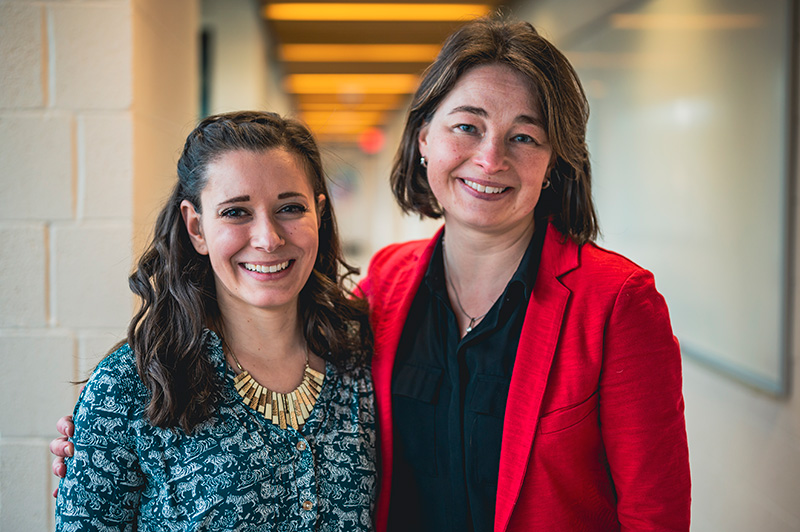
Marissa Cusimano ’19 was the first student to get involved after she submitted a grant application through Tri-Beta Honors Society and was awarded funds to pursue research in Thévenin’s lab. She generated ERK from E. coli and took it in its pure form to see how it phosphorylated Cx43. “This was then used to assess phosphorylation patterns by ERK,” says Cusimano, who is currently a PhD candidate in the Neurobiology and Anatomy Department at Drexel University.
Next, Victoria Vargas ’21 worked on the p38 protein and its phosphorylation of Cx43. “I worked as an independent study student for a year, transitioning into an honors thesis my senior year,” says Vargas, who is currently working as a NICU (neonatal intensive care unit) nurse with the goal of pursuing nursing research or education.
Sonal Arora ’21 worked on JNK and Cx43 phosphorylation, with funding support from the Biological Sciences Department at Moravian. “My work involved bacterial expression and purification from E. coli to create enough active JNK to phosphorylate Cx43 and its sites,” she says. Arora is in her third year at Temple Kornberg School of Dentistry. “Being published in a well-respected journal is more so a physical reminder of what I already knew about Dr. Thévenin’s passion and research story about Src, Cx43, and MAPKs,” she says.
Liz Perez ’22 studied the best cellular conditions to activate ERK, JNK, and p38, aiming to identify the best activators and inhibitors. It involved a lot of trying and failing and took two years in the lab. “This meant a lot of western blotting!” says Perez, who is currently working as a scientist in microbiology analytical research and development at Merck. “I am overwhelmed with joy at this well-deserved recognition that Dr. Thévenin and my fellow undergraduate co-authors are receiving. It proves that undergraduate students can still be involved in innovative graduate level work.”
Reem Turk ’22 spent a year in the lab, answering two questions: 1. Does phosphorylation by MAPK positively or negatively regulate Cx43/Src interaction and 2. Which MAPKs are involved—ERK, JNK, or p38? “I identified phosphorylation patterns between ERK, JNK and p38 and several sites on the Cx43 protein,” she says. “Dr. Thévenin’s work is not just significant academically but has potential real-world applications. Most type of cancers are associated with gap junction defects, and the more we understand the nuances of protein-protein interactions involving Cx43, the closer we are to identifying therapeutic agents that manipulate or even mimic these interactions,” she says. Her participation was funded by the Department of Biological Sciences..
Lauren Latchford ’24, the first author on the study, was in the lab the longest, and her work was funded by the NIH grant and the Moravian University Department of Biological Sciences for two summers. Building on Perez’s efforts, Latchford tried to activate ERK, JNK, and p38 all at once. “I spent time culturing different cell lines (both cancerous and healthy) for experimental use,” says Latchford, who is in her first year of medical school at Touro College of Osteopathic Medicine. “I also created numerous concoctions of different cellular growth factors, inhibitors, and supplements that we treated the cultured cells with to reach desired outcomes. I then put together detailed figures that summarized the results,” she says. She presented her portion of the research at the Protein Phosphorylation Conference in Steamboat Springs, Colorado, in summer 2023.
When Thévenin sent the first version of the study to JBC, the journal editors requested several additional experiments. They wanted multiple repeats and more specifics from Latchford, so she spent the second summer doing additional repeats and functional assays.
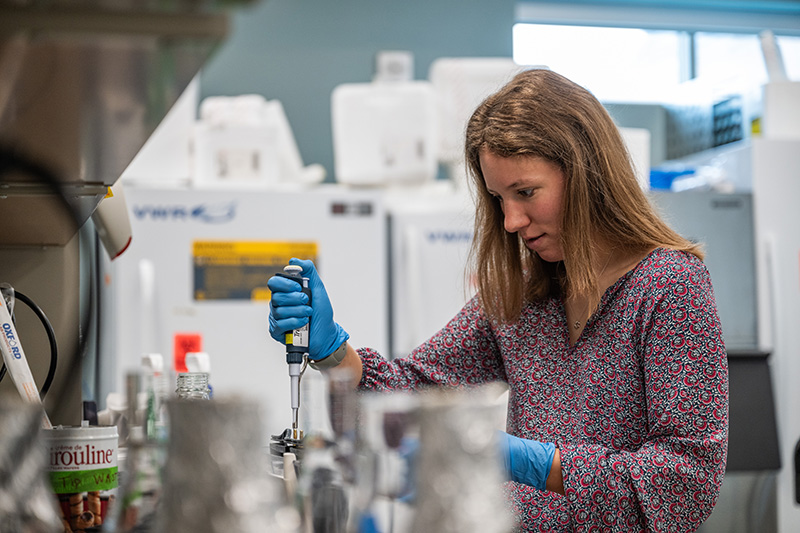
Sophia Shienvold ’24 helped to run several western blots and gels and purified Cx43 proteins needed for the experiments. Her work was funded through the R15 grant. “The JBC paper definitely put Moravian University on the map in the gap junction and phosphorylation fields,” says Shienvold, who is currently a first-year biological sciences PhD student at the University of Delaware. “I remember reading JBC papers and thinking that the high-profile journal would not be something I would be published in for a while, if ever,” she says.
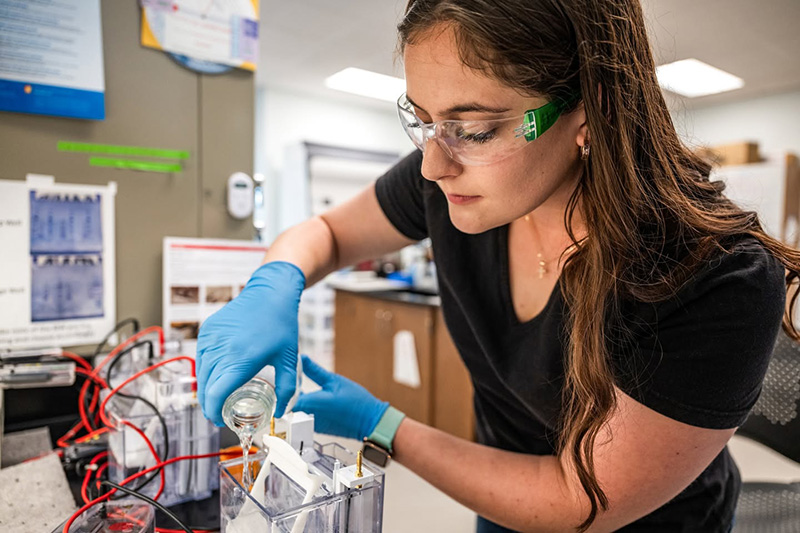
Hailey Belverio ’25, a biology major at Moravian who plans to pursue a PhD in pathology, assisted with experimental repeats that were necessary for publication revisions. She participated thanks to the funding from the NIH grant as well as independent research and a current honors project through the Moravian University Honors Research Program. “Everything I know about research is thanks to Dr. Thévenin and my research mentors on this paper,” she says.
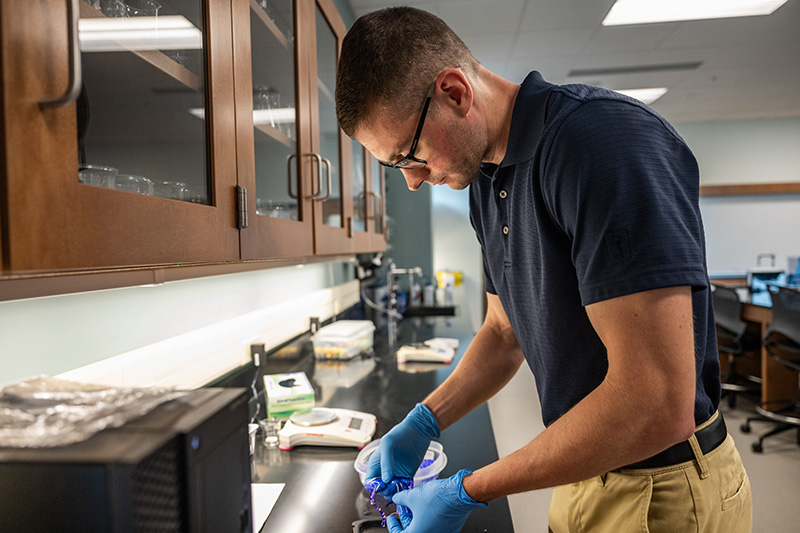
Ryan Kulp ’25 made additional Cx43 mutant proteins for the revision, exploring a novel site (threonine 290) described in the article. “When the JBC reviewers saw that we had discovered a new target for ERK phosphorylation (threonine 290), they wanted us to take a deeper look at that specific site,” Thévenin says.
Importantly, in addition to cellular and protein biochemistry approaches in the lab, the Thévenin group collaborated with two scientists from MIT: Forest M. White and his post-doctoral researcher, Jason Conage-Pough. Forest White is an expert on assessing protein phosphorylation by a technique called mass spectrometry. This approach allows one to quantitatively compare levels of protein phosphorylation between samples. MIT’s mass spectrometry analyses of protein samples generated by undergraduates at Moravian helped support the hypothesis of the study.
Reflecting on what led up to the publication in JBC, Thévenin says she couldn’t have done it without her hardworking undergraduate team.
“So much goes into a research project like this. With students coming into the lab for one to two years, piece by piece, we chipped away at our hypothesis and eventually came to our results,” Thévenin says. “I couldn’t be prouder of their work!”